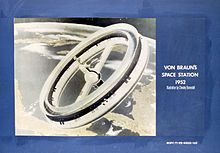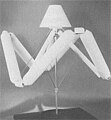Rotating wheel space station: Difference between revisions
added redirected term "von Braun wheel" to lede |
|||
| Line 1: | Line 1: | ||
[[File:Von Braun 1952 Space Station Concept 9132079 original.jpg|thumb|Rotating wheel space station. [[Wernher von Braun]] 1952 concept]] |
[[File:Von Braun 1952 Space Station Concept 9132079 original.jpg|thumb|Rotating wheel space station. [[Wernher von Braun]] 1952 concept]] |
||
A '''rotating wheel space station''' is a hypothetical wheel-shaped [[space station]] that rotates about its axis, thus creating an environment of [[artificial gravity]]. Occupants of the station would experience [[centripetal acceleration]] according to the following equation, |
A '''rotating wheel space station''', or '''von Braun wheel''', is a hypothetical wheel-shaped [[space station]] that rotates about its axis, thus creating an environment of [[artificial gravity]]. Occupants of the station would experience [[centripetal acceleration]] according to the following equation, |
||
: <math>a = -\omega^2 r</math> |
: <math>a = -\omega^2 r</math> |
||
Revision as of 05:30, 13 July 2018

A rotating wheel space station, or von Braun wheel, is a hypothetical wheel-shaped space station that rotates about its axis, thus creating an environment of artificial gravity. Occupants of the station would experience centripetal acceleration according to the following equation,
where is the angular velocity of the station, is its radius, and is linear acceleration at any point along its perimeter.
In principle, the station could be configured to simulate the gravitational acceleration of Earth (9.81 m/s2).
History
Both scientists and science fiction writers have thought about the concept of a rotating wheel space station since the beginning of the 20th century. Konstantin Tsiolkovsky wrote about using rotation to create an artificial gravity in space in 1903. Herman Potočnik introduced a spinning wheel station with a 30-meter diameter in his Problem der Befahrung des Weltraums (The Problem of Space Travel). He even suggested it be placed in a geostationary orbit.[citation needed]
In the 1950s, Wernher von Braun and Willy Ley, writing in Colliers Magazine, updated the idea, in part as a way to stage spacecraft headed for Mars. They envisioned a rotating wheel with a diameter of 76 meters (250 feet). The 3-deck wheel would revolve at 3 RPM to provide artificial one-third gravity. It was envisaged as having a crew of 80.[1]
In 1959, a NASA committee opined that such a space station was the next logical step after the Mercury program.[2] The Stanford torus, proposed by NASA in 1975, is an enormous version of the same concept, that could harbor an entire city.[citation needed]
NASA has never attempted to build a rotating wheel space station, for several reasons. First, such a station would be very difficult to construct, given the limited lifting capability available to the United States and other spacefaring nations. Assembling such a station and pressurizing it would present formidable obstacles, which, although not beyond NASA's technical capability, would be beyond available budgets. Second, NASA considers the present space station, the ISS, to be valuable as a zero gravity laboratory, and its current microgravity environment was a conscious choice.[3]
More recently, NASA has explored plans for a Nautilus X centrifuge demonstration project. If flown, this would add a centrifuge sleep quarters module to the ISS. This makes it possible to experiment with artificial gravity without destroying the usefulness of the ISS for zero g experiments. It could lead to deep space missions under full g in centrifuge sleeping quarters following the same approach.[citation needed]
Gallery
-
Stanford torus, 1975 NASA concept.
-
Deployment of a hexagonal inflatable rotating space station.1962 NASA concept.
-
Hexagonal inflatable rotating space station.1962 NASA concept
-
Description of a rotating wheel space station in Herman Potočnik's The Problem of Space Travel (1929)
-
A NASA engineer takes a walk in simulated zero gravity around a mock-up of a full-scale, 7.3 m (24 ft) diameter space station in 1964.
-
Proposed Nautilus-X
In fiction
Many space stations and ships use a rotating design.[4]
1968: Arthur C. Clarke's novel 2001: A Space Odyssey was developed concurrently with Stanley Kubrick's film version of 2001. In it, the rotating space station Space Station V provides artificial gravity and features prominently on the book's first-edition cover.
1984: The Peter Hyams directed film 2010 features a battleship-size, Russian built spacecraft (designed by futurist artist Syd Mead), the Leonov, which has a continuously rotating central section, providing an artificial gravity for the occupants.
1985: The novel Ender's Game features a multi-ringed station, called "Battle School," with varying levels of simulated gravity. As the characters ascend through the station towards the center, there is a noticeable decline in the feeling of gravity.
1994: The humans in the science fiction series Babylon 5 use rotating sections to provide artificial gravity. Earth Alliance space stations such as the Babylon series (hence the name of the series), transfer stations such as the one at Io near the main Sol system jump gate, and EarthForce Omega-Class Destroyers made extensive use of rotating sections to lengthen deployment times and increase mission flexibility as the effects of zero gravity are no longer a concern.
1999: The Japanese manga and anime Planetes has its main story set in "The Seven," the 7th wheel orbital station, and a 9th is under construction by 2075. In the Zenon trilogy (Zenon: Girl of the 21st Century, Zenon: The Zequel and Zenon: Z3), 13-year-old Zenon lives on a rotating space station owned by the fictional WyndComm from 2049 though 2054, but it is not designed in a way that would allow for artificial gravity through centripetal force.
2003: In the re-imagined series Battlestar Galactica. Ragnar Anchorage is a three ringed weapons storage station, and the civilian ship Zephyr is a luxury liner featuring a ringed midsection.
2007: The "Presidium" sector of the Citadel space station in the Mass Effect series of video games comprises a rotating toroidal section connected to a docking ring, with five large "wards" radiating out from the central ring like a flower's petals. In addition, Arcturus Station, the human seat of government on the galactic stage (not shown in the games, but described in detail) is also mentioned as being a rotating Stanford torus.
2011: Most space stations in the Expanse series make use of artificial gravity by rotation, most notably Tycho Station. Even larger celestial objects like Ceres and Eros have been hollowed out and spun up to generate gravitational pull for their inhabitants.
2013: The Neil Blomkamp film Elysium has an enormous space station called Elysium (an open-roofed station 20 to 45 kilometres (12 to 28 mi) in diameter[5], somewhere between a much-larger open-roofed Bishop Ring and a smaller, fully enclosed Stanford Torus.) The station in the movie supports a city and habitat for the privileged upper classes of Earth.
2014: A vessel very similar in design to the NASA-designed Nautilus-X was used in Interstellar. The ship, known as the Endurance, was used as a staging station also capable of interplanetary flight.
2014: Space stations in the video game Elite: Dangerous (and its prequels) rotate to create artificial gravity.
2015: Thunderbird 5 in the ITV TV show Thunderbirds Are Go features a rotating gravity ring section on the space station which features a glass floor to observe the Earth below. The series is set in the year 2060. The NASA-designed Hermes in the film The Martian was capable of space travel to Mars.
See also
- Space habitat
- Space colonization
- Weightlessness
- Stanford torus, a design for a 1.8 kilometres (1.1 mi) diameter space habitat capable of housing 10,000 to 140,000 permanent residents, proposed in 1975 by NASA.
- Bishop Ring (habitat)
- O'Neill cylinder, a 5 miles (8.0 km) diameter space settlement design proposed in 1976 by Gerard K. O'Neill.
- Ringworld
- Man Will Conquer Space Soon!, a famous series of 1950s magazine articles detailing Wernher von Braun's plans for manned spaceflight.
- Mars Direct, proposal for a manned Mars mission. It contains a design to generate artificial gravity by tethering a "Habitat Unit" to a rocket stage and rotating them about a common axis.
- Space stations and habitats in popular culture
References
- ^ Ryan, Cornelius (editor; also associate editor of Collier's magazine—it is stated on the dust jacket flap that half of the contents of the book initially appeared in the Collier’s magazine series of articles "Man Will Conquer Space Soon!") Across the Space Frontier New York: September 1952, Viking Press. See Chapter 4 by Willy Ley--"A Station in Space" Pages 98-117; frontispiece of book has Chesley Bonestell illustration of entire wheel space station in orbit above Central America; pages 106 and 107 has cutaway illustration of interior of wheel space station; page 100 mentions that it is designed for a crew of 80. In the introduction on page xii it is mentioned that the rotating wheel space station will orbit 1,075 miles above Earth and will cost $4,000,000,000 in 1952 dollars.
- ^ Space station. Retrieved from http://www.daviddarling.info/encyclopedia/S/space_station.html.
- ^ "Home, Sweet Home". NASA. 25 May 2001. Archived from the original on 2006-09-29.
- ^ List of popular fiction space stations; not all centrifugal: http://tvtropes.org/pmwiki/pmwiki.php/Main/SpaceStation
- ^ Allain, Rhett (5 June 2013). "Gravity in the Elysium Space Station". Wired.com. Archived from the original on 22 December 2016. Retrieved 22 May 2018.











